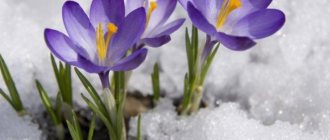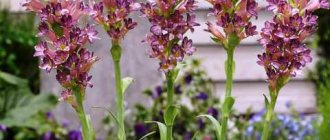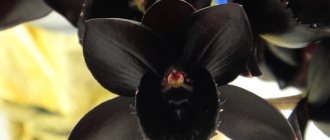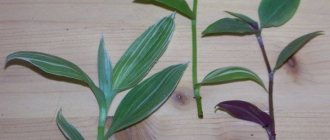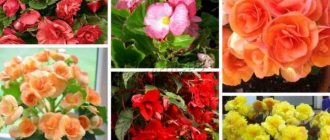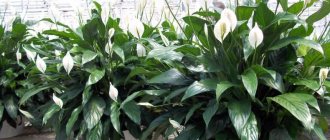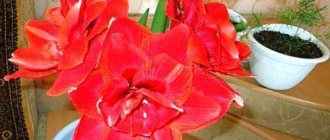Somehow it became the custom among amateur flower growers that hippeastrums and amaryllis are complex, capricious and unpredictable plants. I assure you, this is not at all true. Today I will teach you how to tame the obstinate.
So, hippeastrum has fallen into your gentle and caring florist hands. Shall we bloom it?
They began to grow amaryllis and hippeastrum in European countries with temperate and cold climates only at the end of the 17th century, when greenhouses began to appear in botanical gardens and among lovers of floristic rarities. Sailors, botanists, and plant hunters encouraged by traders brought to Europe all the most unusual things they could find on difficult and dangerous expeditions that often ended tragically.
The genus Amaryllis, the predecessor of Hippeastrum, was established in 1737 in the work Hemera plantarum. Botanists previously referred to the plants classified as lilies (Lilium) and lion daffodils (Lilio narcissus).
Experienced flower growers know that caring for hippeastrum does not take much time: one transplant per year, two rearrangements, watering, infrequent feeding.
So what is the secret of this plant's annual flowering?
Indoor flower hippeastrum - description
Some gardeners confuse two similar crops - hippeastrum and amaryllis. But plants have their differences, although they are similar to each other.
What does hippeastrum look like?
Hippeastrum leaves reach 50 cm in length and 7 cm in width. The bulb in adult plants grows up to 10 cm in diameter.
On a long stalk, which sometimes exceeds 100 cm, huge flowers bloom - 20 cm in diameter when fully opened. There are from 2 to 10 flowers on one peduncle.
Hippeastrum and amaryllis: differences
To an experienced eye, the differences between these plants are immediately visible:
| Hippeastrum | Amaryllis | |
| Motherland | South America | South Africa |
| Bulb (shape, color of scales) | Elongated or round, brown-yellow scales. | The pear-shaped bulb is covered with gray scales. |
| Flowers | There are 4 flowers in one inflorescence, less often 9-10. | There are from 6 to 12 flowers in one inflorescence. |
| Flowering period | Blooms in late winter or early spring. | Autumn |
| Peduncle | Inside with cavity | No cavity |
| Sheet plates | Elongated, smooth or rough. | Smooth, narrow, with a groove in the middle. |
How long does it take to live at home?
The flowering period lasts 3 weeks. If one bulb produces several peduncles, the flowering period increases.
The lifespan of flowers is affected by temperature. If the room is always +25°C, the flowers quickly bloom and fade. To enjoy the beauty of the buds longer, it is recommended to maintain the room temperature at +18-20°C.
What does it mean in translation
Translated from Greek, hippeastrum means “horseman” and “star”.
What should you do after purchasing?
The peculiarity and distinctive feature of hippeastrum is the peduncle - a hollow tube, and, for example, in Ammarilis, the flower arrow is filled with tissues. The peduncle is cylindrical, the surface is smooth, covered with a waxy coating. The arrow extends 40-80 cm in height, depending on the variety and age of the flower. The color is light green, some varieties are dark.
After flowering, the flower arrow of the hippeastrum gradually dies. It is dangerous to immediately cut off the peduncle; the integrity of the bulb is damaged (the risk of rot and infection with harmful infections). Only faded flowers are removed first.
Pro Tips:
- Buy Hippeastrum in autumn or spring (to replant immediately).
- Carefully examine the bulb itself (it should be hard, juicy, at least 6-7 cm in diameter, without rot, reddish marks or seals).
- Turn the pot over so that the root shoots should be visible through the drainage holes).
The landing procedure is simple:
- Select the size of the pot, treat the inner surface with steam or boiling water.
- The substrate and drainage are prepared, disinfected (calcined in the oven or spilled with disinfectants).
- Dry and rotten fragments are cut off, the neck and bottom are thoroughly cleaned, and shoots that are too long are trimmed.
- Treat the onion (soak for 20 minutes) with disinfectants (Maxim, Aktara).
- Dry the planting bulbs.
- 2-3 holes are made in the container (for water drainage and air exchange).
- 3-4 cm of drainage material is poured onto the bottom.
- The earthen mixture is poured almost to the top.
- Place the bulb in the center and make a small hole.
- The roots are laid evenly.
- Deepen to a third of the bulb's growth.
- Gently pour a stimulant solution (Epin, Zircon, Extrasol) along the edge.
- Place in a bright, warm place.
Popular varieties of indoor hippeastrum with photos and names
Among the varieties there are miniature hybrids, as well as those with long-tubular, orchid-like, double and simple flowers.
Leopold
The most common variety. A white border runs along the edges of the pink petals. Toward the base, the white edge turns green.
Lady Jane
The flowers are large, double, and peach-colored. There is a pink vein running down the center of the petals. The flowers reach 20 cm in diameter.
Spotted
The variety first produces flowers, then leaves. Red spots are randomly scattered across the cream petals. The throat is colored yellow-green.
Regina (Royal)
The flowers are deep red, the peduncle is 50 cm long. The foliage appears after flowering.
Narrow-leaved
Based on the name, the variety has long, narrow leaves. Petals are orange. Up to 9 flowers can bloom simultaneously on one peduncle.
Features of care after flowering and during the dormant period
After flowering, hippeastrum needs special care to regain its strength. The leaves continue to grow actively, the bulb must be nourished, and in order for this process to proceed without deviations, it is worth creating favorable conditions for the plant.
It is contraindicated to cut the flower arrow to the very root. This will damage the head, causing the root to rot and the flower to die.
Trimming is done like this:
- First, you should get rid of faded flowers so that the plant does not continue to feed them;
- cut the arrow so that its height is ten to fifteen centimeters;
- the remaining stump should dry, then it is carefully removed from the pot with rotating movements;
- Three centimeters of soil are poured out of the pot to add fresh, fertilized soil (it is important that it is identical in composition to the previous soil).
Hippeastrum needs rest, for this they observe a rest regime.
During the flowering period, the bulb should rest. The rest period begins in mid-September. From the last days of July you should stop fertilizing the soil. From the tenth of September, watering stops. As soon as the leaves dry, the plant is left in a dark room, at a temperature of ten to fourteen degrees until January.
In February, the flower is awakened and transferred to a lighted and warm place. Watering and fertilizing are being restored. In a few months the plant will bloom again.
Rules for keeping a flower at home
For the luxurious annual flowering of hippeastrum, you will need to follow the rules of care.
Temperature
The optimal temperature for development is +21-22°C in summer, in winter – +16-17°C. Temperature changes are necessary for flowering.
Lighting
The culture prefers diffused light. The ideal location for a flower pot would be a window sill on the southwest side.
The soil
Bulbs develop better in fertile, loose substrate. You can buy ready-made soil for hippeastrum or prepare it yourself from turf soil, sand and peat.
Choosing a pot for a bulbous plant
The Cavalier Star does not like space and grows better in a cramped pot. Therefore, the answer to the most common question from gardeners - why hippeastrum does not bloom at home - is to grow it in a pot that is too spacious.
Attention! The roots grow deep, so the container when growing hippeastrum should be deep, but not wide.
Watering
When the Cavalier Star is actively developing, it is watered often, after the earthen clod has dried out. Then, when flowering ends, watering is reduced.
Feeding
As soon as the flower shoot reaches 12 cm, mineral fertilizers with a predominance of phosphorus and potassium are applied once every 2 weeks.
Transfer
Young specimens are replanted every year, adults - once every 3 years. In the absence of replanting, it is recommended to replace the top layer of soil annually. It is better to carry out the procedure in the spring, immediately after flowering.
The nuances of pruning: do you need to trim the leaves?
After flowering ends, the peduncle is completely cut off and the plant is fed.
Answers to popular questions
Most often, amateurs ask the same questions. We offer a small educational program for beginners.
Why doesn't it grow well?
If there has not been a full winter rest, where will the plant get the strength to grow, much less shoot out flower stalks? It is strange to expect active development from an exhausted pet.
The reason may lie in:
- poor lighting;
- depleted soil;
- lack of moisture.
How to wake up a bulb after hibernation?
A couple of weeks after the New Year, the hippeastrum is moved to its rightful place. After waiting for the first arrow to appear, they begin to water again (at first very moderately). After about 3 weeks you can start feeding.
https://youtube.com/watch?v=M-DTLW1hMPM%2520
How to rejuvenate a bulb?
The procedure is complex, but effective:
- at the end of flowering in November, cut off that part of the bulb that is above the ground;
- clean off all outer layers;
- make vertical cuts crosswise;
- separate segments from each other;
- regularly moisten the soil.
After six months, new “babies” are formed on the segments.
How do you know if a flower is exhausted?
Signs will be weak flowering, and in particularly advanced cases - the complete absence of peduncles. When transplanting, it is noticeable that the bulb has decreased in size and looks dried out.
How to resuscitate?
When diseases develop, it is important to determine the number of diseased bulbs and isolate them from healthy plants. Diseased scales are removed from the affected specimen, rotten areas are cut off with a sharp knife with a sterilized blade.
Diseased scales are removed from the affected specimen, and rotten areas are cut off with a sharp knife with a sterilized blade.
It is a good idea to treat it with an antifungal drug (for example, Maxim or similar) and dry it well. Next, the bulb can be planted in the substrate and sprinkled with “Fundazol”. Water moderately.
Reproduction - methods
The easiest way to obtain new plants is to separate the children. The procedure is performed at the time of transplantation. Small onions, at least 2 cm in diameter, are separated from the mother bulb.
If the variety does not produce children, the crop can be propagated by dividing the bulb. To do this, you will need to cut off the foliage, trim the roots and divide the bulb into 2 parts. Each of them should have a part of the bottom with roots. The sections are powdered with coal, left for 2 days to dry, then planted in the soil.
When propagating by scales, the bulb is cut into 8-10 parts. Each part with a bottom is sprinkled with activated carbon, dusted with a root formation stimulator and planted in moss or sand.
Hippeastrum seeds have a short shelf life, so they are buried in the soil to a depth of 1 cm immediately after collection. The advantage of this method is the production of new, beautifully flowering plants, because those propagated by seeds do not repeat the characteristics of the mother plant.
Hippeastrum care
The techniques and methods of caring for the plant do not have any features that distinguish them from other flowers, with the exception of a few.
Lighting
The light for a flower needs to be bright, but diffused. Direct exposure to sunlight can cause burns to tender leaves.
For uniform development of all parts of the crop, the flower pot is regularly turned to the light in different directions. When growing a flower in an apartment, a suitable place to place it would be a window sill in the southern part of the room.
Temperature
The air temperature in the room, which is comfortable for the flower, should be in the range from seventeen to twenty-five degrees Celsius. This temperature regime must be maintained throughout the growing season.
During the rest period, the temperature should be reduced. One of the features of caring for this flower is the desirability of placing it outside in the summer.
The most preferred method for this would be to bury it in the ground directly with the pot. At the same time, it is important to protect it from strong winds and drafts, and also to provide it with good drainage, eliminating stagnation of water near the root
Air humidity
The mode of maintaining air humidity is observed naturally for normal room conditions. Humidification is required only during the period when the heating devices are turned on to greatly dry out the air in the room.
Watering
However, the plant's watering regime is not simple. It is very important to ensure proper flower development.
The beginning of the growing season for a crop begins when a peduncle grows from the bulb. Until this point, watering should be moderate and done only after the top layer of soil in the pot has dried.
As soon as the growing season begins, watering increases in volume and becomes more frequent in time.
Stagnation of moisture at the roots of the plant is unacceptable. For this, gardeners use a special watering method, the so-called bottom. When using this method, water is not added to the soil from above, but is poured into a tray on which the flower pot stands. This is done until all the soil in the pot is saturated with moisture.
Once this effect is achieved, excess water is removed from the pan. It is possible to carefully water the plant from above, but you need to make sure that the water does not get on the flower bulb.
After flowering stops, watering begins to be reduced. By mid-autumn, when the crop enters a dormant period, it is not watered at all. The flower spends this time in a dark, dry, warm place until the end of January.
At the end of this period, the hippeastrum is watered again, starting with a small amount of water added to the soil. At the same time, they begin to feed the bush using complex mineral fertilizer for flowers, dissolved in water for irrigation.
If the time period is observed correctly, the plant will begin flowering within a month and a half after that.
Top dressing
Flower feeding is applied once every two weeks. After the flower shoot grows, fertilizers intended for deciduous ornamental plants are applied to the soil in liquid form.
When the shoot on which the flowers form grows completely and the plant has leaves, the fertilizers are changed to mineral fertilizers for flowers.
Such a change will have a beneficial effect on the formation and development of buds. From the moment the buds form until flowering, the crop must be treated with a weak solution of potassium permanganate applied to the soil.
- A week after this, fertilizer with a high phosphorus content is added to the usual solution of complex mineral fertilizer.
- When preparing a solution to fertilize a flower, you should use only half the recommended dose so as not to harm the delicate roots.
- In the process of caring for hippeastrum, you need to periodically wipe the leaves with a soft damp cloth to remove dirt, and also sometimes take a shower with warm water.
Preparing for winter
Preparing the plant for the dormant period begins in early autumn, after flowering has stopped. The timing and abundance of flowering for the next year depends on the timeliness and correctness of this preparation.
Flowers placed outside are brought into a warm room. The amount of water used for irrigation is gradually reduced until watering stops completely.
- By mid-September, the foliage, which will begin to gradually dry out, will dry out completely and fall off. After this, the main shoot of the bush is shortened to the root collar, and the pot with the bulb is placed in a dry, dark place.
- The temperature regime is reduced to a range of six to twelve degrees Celsius.
- The hippeastrum should remain in this state throughout the entire dormant period, until the end of January. At the end of this time, the plant is again placed on the southern windowsill, and watering and fertilizing also begin.
In the case when the flowering of a plant is delayed or absent altogether, this means that feeding is insufficient.
A flower usually has little soil in a pot, so if nutrients are rarely added to it, they will be quickly absorbed by the plant. Therefore, you need to carefully monitor the correct regular feeding and watering of the flower.
- If you have already limited watering, bringing it to a minimum, then stop it completely and after a couple of days, place the pot with the plant in a dark, cool room.
- If there is no such place, a dark place in the least heated room will do (make sure that the temperature in it does not drop below 12°C).
- In such an environment, the plant will overwinter until the end of the season. The leaves will, of course, continue to fall. Remove these and dead tissue from the bulb to avoid plant rot that may occur when constant irrigation returns.
However, we note that the above algorithm is valid for fairly mature plants that already bloom regularly (as a rule, they are about 4 years old). If your plant is younger, do not force it to drop its leaves on purpose. In winter, they also go into hibernation - new leaves no longer grow, and the old ones that appeared over the year die off.
There is a possibility that hippeastrum will want to bloom in November or even December instead of wintering. This option is possible - the plant has confused autumn with winter, especially if you have extended the moisture and fertilization. Let the hippeastrum bloom, just do not supply it with water abundantly and often.
Perhaps it is already flooded, and this flowering will be the last. Monitor the safety of the plant and its appearance. If the size of the peduncle and buds is within normal limits, and the petals please you for no more than two weeks, then the flower is fine, only the chance of flowering next spring is extremely small.
The soil
For planting a plant, its proper cultivation, as well as timely flowering, a certain composition of the soil in a container intended for its growth is required. You can prepare it yourself.
The soil mixture in this case should consist of leaf soil, humus, turf soil, and sand. After mixing these components, the resulting substrate is sterilized.
At the bottom of the container you need to install drainage made of pebbles or other suitable material.
How to make a plant bloom
To flower, you need to properly care for the crop.
Flowering conditions
Before flowering, the plant must have a dormant period in a cooler room. Then the pot with the bulb is transferred to a warm room and the soil is watered.
Care during the flowering period
After the peduncle appears, watering is carried out with warm water and fed with mineral fertilizers once every 2 weeks.
Care after flowering
If the leaves have wilted, they should be removed and the peduncle trimmed. Store the flower pot in a cool, dry place. When the dormant period is over, the plant is brought out into the light and watered thoroughly.
Feature of the plant
Hippeastrums differ from other bulbous flowers in that they can be sent for forcing at a convenient time and forced to bloom when needed. Flowering begins from March and green leaves remain until September. In the fall, they need to be prepared for winter, dug up, cleaned and stored in a cool, dark place for 2 to 3 months.
If you plant a hippeastrum bulb in a flowerbed in the summer, it will bloom again. The main thing that a flower requires for good growth and abundant flowering is good lighting with direct sunlight and abundant watering.
Diseases and pests of hippeastrum with photos and their treatment
Pests that damage hippeastrum:
- onion mite;
- amaryllis mealybug;
- false scale insect;
- mealybug.
Insecticides are used to control parasites. If you don't get rid of insects, they can become carriers of diseases:
- root rot (fusarium);
- stagnospora;
- anthractose.
Fungal diseases are treated with Fundazol and Bordeaux mixture. But before treatment, the diseased plant is isolated from healthy ones.
Folk signs and superstitions
Hippeastrum is a flower for fulfilling desires, as signs and superstitions say. Helps in love, promotes mental development. Leaning over a young plant, you need to whisper your wish, firmly believing in its fulfillment.
You can recognize an intruder by the flower. When a stranger comes to the house, he is offered to touch the petals of a flower. If the flowers droop after the stranger leaves, it means the person had malicious intent.
Young single people who dream of finding their chosen one should plant a hippeastrum bulb and grow a culture on their own. An acquaintance can develop into a serious relationship.
Attention! You cannot sort things out near the plant, as this can contribute to frequent quarrels and failures.
Hippeastrum is necessary for creative people - it activates hidden talent. Writers, artists and other representatives of creative professions are advised to buy culture.
During flowering, hippeastrum spreads positive energy around itself, so it is recommended to place a pot with the plant in the central part of the apartment so that it fills it with positivity.
Hippeastrum is a beautiful and unpretentious plant of the Amaryllis family. In order for the culture to please with its huge flowers 2 times a year - in winter and summer, you will need to follow the rules of caring for the plant: plant the bulb in nutritious soil, regularly moisten the soil, feed it on time and provide the hippeastrum with a dormant period.
Types of hippeastrum
There are more than 2000 species of this plant. Moreover, each of them often has different flowers. But the most common is the Palace type. It can most often be found in houses and apartments. It has a juicy and large peduncle, bright scarlet flowers. But it is also divided into such types as:
- Red with narrow green stripes on the flowers.
- The royal has pointed flowers and is often a tall plant.
- The columnar type has flowers of an orange-pink hue, very delicate.
In addition, plants are often classified according to their origin, flower shape and other indicators. Hybrids are represented by such groups as: mixes with orchids, combinations with belladonna. There is also a hybrid called "Leopold" and others. But most often the following types of this plant are found in rooms and interiors:
Harrison
A species native to Uruguay. The flowers have a white tint, with a thin red stripe running down the center of each flower, making the plant very striking. Whimsical, difficult to care for. High soil and air humidity are required, but temperatures should not be high. Feels uncomfortable in a hot room. Need coolness.
Nelson
Quite a rare species for natural conditions. But in Bolivia you can still find it. It has a very interesting shape and amazing color. The petals of each flower are cream-colored and have a deep red edge. Care is also quite difficult, with frequent watering.
View Doran
The Doran species grows in nature along the banks of the Orinoco River (South America, Venezuela). The petals of each flower are bright pink, edged with white stripes. It looks very impressive. But, like others, this variety is demanding in care.
Argentine variety
It has very original flowers with corrugated petals. The flowers are usually white and often have a subtle, delicate aroma.
Almost all types of hippeastrum emit aromas when flowering. With proper and competent care, the plant blooms at least once a year, sometimes more often.
